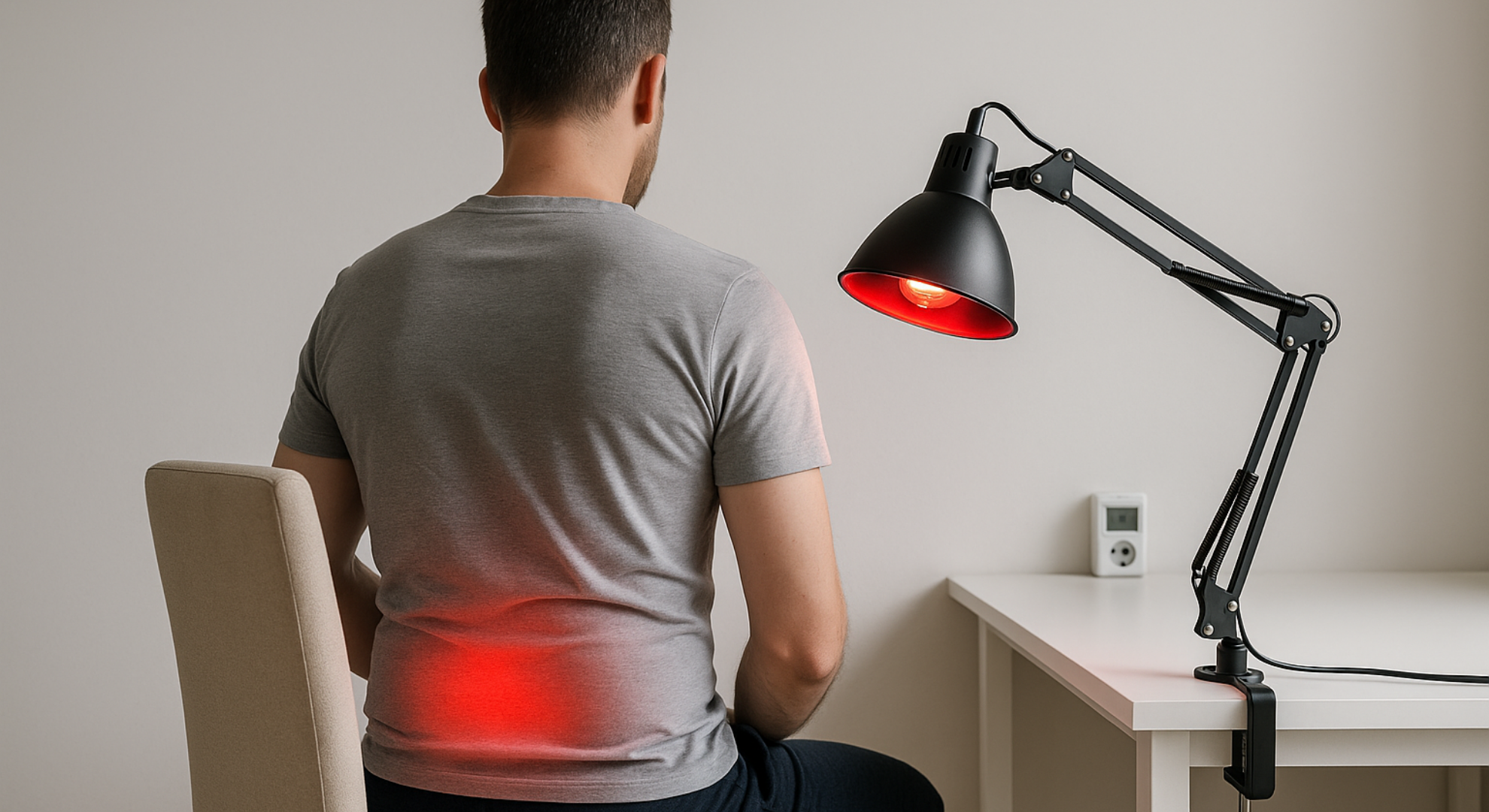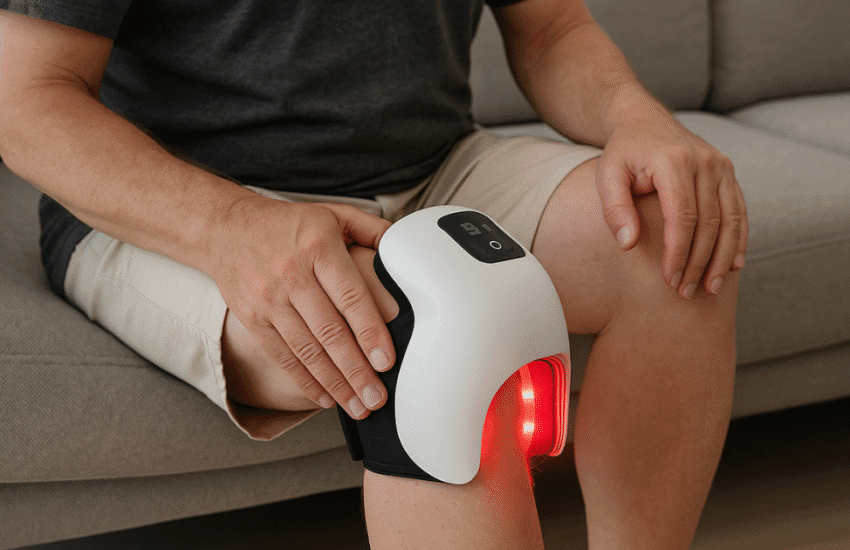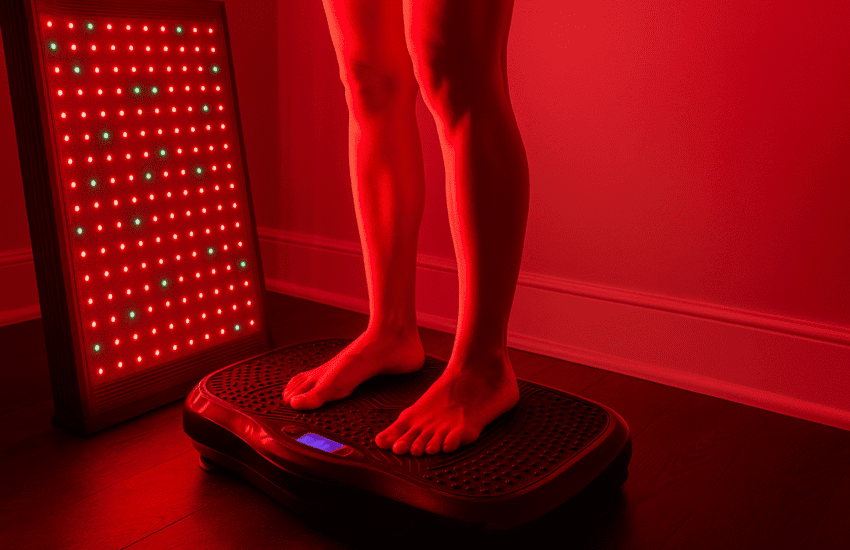How to Use Infrared Lamp for Back Pain: Setup and Safety Guide
Editor’s pick: For a hands-free setup that‘s easy to angle at your lower back, try the Beurer IL60 with its built-in timer. Check price on Amazon.
If you’re someone that’s battled chronic back pain for years, you may have tried countless treatments in search of relief. Infrared therapy has been positioned as a non-invasive and drug-free approach to managing pain.
This guide covers proper setup, session timing, safety protocols, and when infrared therapy may help—so you can use it safely from your first session.
Disclosure: As an Amazon Associate I earn from qualifying purchases at no extra cost to you.
Understanding the Science Behind Infrared Therapy
Infrared light is a type of electromagnetic radiation that we perceive as heat. Unlike visible light, infrared waves can penetrate deep into our body tissues beneath the skin’s surface.
This deep-reaching capability makes infrared therapy particularly useful for muscle and joint pain.
When infrared light penetrates our tissues, it triggers a series of useful physiological responses:
- Increased blood circulation: Enhanced blood flow brings more oxygen and nutrients to the affected tissues, speeding up healing and reducing inflammation.
- Stimulation of collagen and elastin production: These proteins are crucial for maintaining healthy, flexible tissues.
- Reduction of inflammation: By decreasing levels of pro-inflammatory cytokines, infrared therapy can provide substantial relief from chronic inflammation, often at the root of persistent back pain.
In my experience, regular infrared treatments have helped reduce the frequency and intensity of my back pain flare-ups.
Pros & Cons of Infrared Lamps for Back Pain
Pros:
- Penetrates deeper tissue than surface heating pads
- Hands-free operation during work or reading
- Adjustable positioning for targeted lower back areas
- No medications or topical chemicals required
- Affordable one-time device purchase
Cons:
- Requires consistent use (3–5 weeks) before most users notice changes
- Less effective in bright rooms or over heavy clothing
- Positioning demands attention to distance and angle
- May disturb partners if used before bed
- Eye protection necessary during extended sessions
Choosing the Right Infrared Lamp
Selecting a high-quality infrared lamp is crucial for effective treatment. Look for devices designed specifically for therapeutic use, with the following features:
- Adjustable settings
- Wavelengths between 700 nanometers to 1 millimeter (optimal for deep tissue penetration)
- Safety certifications
- Sturdy construction for long-term use
I recommend researching reputable brands and reading user reviews before making a purchase. While quality infrared lamps can be a significant investment, they’re often worth it for the long-term benefits they provide.
Setting Up for a Treatment Session
Creating the right environment for your infrared therapy session is key to maximizing its benefits. Here’s how I prepare:
- Find a comfortable position: I usually lie on my stomach on a massage table, but you could also sit in a chair with the lamp behind you.
- Expose the treatment area: Remove clothing from the area you’re treating or wear thin, light-colored clothing to allow most penetration of the infrared light.
- Position the lamp: Place it about 12-18 inches away from your back or as per manufacturer’s guidelines. This distance allows for effective treatment without risking overheating or discomfort.
- Adjust the angle: Ensure even coverage of the affected area. For lower back treatment, you might need to angle the lamp slightly upward.
- Set a timer: This helps prevent overexposure and keeps your sessions consistent.
Treatment Duration and Frequency
When starting with infrared therapy, it’s important to begin with shorter sessions and gradually increase the time as your body becomes accustomed to the treatment. Here’s a general guideline:
- Start with 15-20 minute sessions
- Gradually work up to 30 minutes
- For acute back pain, use the lamp once or twice daily
- For chronic conditions, 3-5 times per week is often enough
More isn’t always better with infrared therapy. Excessive use can potentially lead to skin irritation or dehydration. Always listen to your body and adjust the frequency as needed.
Hydration is Key
One aspect of infrared therapy that’s often overlooked is the importance of hydration. The heat generated by the lamp can cause you to sweat, potentially leading to dehydration if you’re not careful.
I always make sure to:
- Drink plenty of water before my session
- Keep a water bottle nearby during treatment
- Rehydrate after each session
Staying well-hydrated helps prevent any negative effects from the heat and supports your body’s natural healing processes.
Maximizing the Benefits of Infrared Therapy for Back Care
To get the most out of your infrared treatments, consider these tips:
- Combine with gentle stretching: After a session, when your muscles are warm and relaxed, is an ideal time for some light stretching or yoga poses.
- Use before physical activity: An infrared session can serve as an excellent warm-up, increasing blood flow and flexibility before exercise.
- Experiment with timing: I find evening sessions particularly useful, as the relaxation effect can improve sleep quality. However, morning sessions might be more suitable if you’re using the lamp to prepare for physical activity or work.
- Be consistent: The real benefits of infrared therapy come with regular use over time. Try to maintain a consistent treatment schedule.
- Target different areas: While you might initially focus on your lower back, don’t hesitate to treat other areas like your upper back or neck if you experience tension there.
Common issues and How to Avoid Them
In my years of using infrared therapy, I’ve encountered (and made) a few mistakes. Here’s how to avoid them:
- Falling asleep during treatment: The warmth can be incredibly relaxing, but it’s important to stay awake and alert to watch your skin’s response and avoid overexposure. Always set a timer.
- Using the lamp on areas with decreased sensation: If you have any neuropathy or numbness in your back, be extra cautious. You might not feel if the area is getting too hot. Use shorter treatment times and keep a close eye on your skin for any signs of redness or irritation.
- Overusing the lamp: Some people think that if a little heat is good, a lot must be better. This isn’t true for infrared therapy. Cranking up the intensity or using the lamp for extended periods can lead to skin irritation, dehydration, or even minor burns. Always follow the manufacturer’s guidelines and start conservatively.
- Neglecting other aspects of back health: While infrared therapy can be incredibly effective, it works best as part of a comprehensive approach to back health. Don’t neglect proper posture, regular exercise, and stress management.
- Expecting immediate results: While you might feel some relief after a single session, the most significant benefits come with consistent use over time.
Be patient and persistent in your approach.
Incorporating Infrared Therapy into Your Overall Back Care Routine
Infrared therapy is a powerful tool, but it’s most effective when used as part of a holistic approach to back health. Here’s how I combine it into my overall routine:
- Morning stretches: I start my day with gentle stretches to loosen up my back muscles.
- Infrared session: Depending on my schedule, I’ll do a 20-30 minute session either in he morning to prepare for the day or in the evening to unwind.
- Regular exercise: I make sure to include exercises that strengthen my core and back muscles, which helps support my spine and prevent future pain.
- Proper ergonomics: I’ve invested in a good office chair and standing desk to maintain proper posture throughout the day.
- Stress management: Techniques like deep breathing and meditation help me manage stress, which can often manifest as physical tension in the back.
- Healthy diet: I focus on anti-inflammatory foods to support overall back health.
- Regular check-ups: I maintain regular appointments with my chiropractor or physical therapist to address any emerging issues before they become serious problems.
By combining these practices with regular infrared therapy, I’ve been able to manage my back pain more effectively than ever before.
Tracking Your Progress
To really understand the impact of infrared therapy on your back pain, it’s helpful to track your progress. Here’s how I do it:
- Pain journal: I keep a daily log of my pain levels, noting any specific triggers or activities that affect my back.
- Treatment log: I record the frequency, duration, and intensity of my infrared therapy sessions.
- Functional improvements: I note any improvements in my ability to perform daily activities or exercises.
- Sleep quality: Since back pain often affects sleep, I track my sleep quality and duration.
- Medication use: If you’re using any pain medications, track whether your usage decreases over time with regular infrared therapy.
By maintaining these records, you can objectively assess the effectiveness of infrared therapy for your specific condition and make informed decisions about your treatment plan.
When to Seek Professional Help
While infrared therapy can be incredibly useful, it’s important to know when to seek professional medical advice. Consider consulting a healthcare provider if:
- Your back pain is severe or getting worse despite treatment
- You experience numbness, tingling, or weakness in your legs
- You have unexplained fat loss or fever along with back pain
- Your pain is affecting your daily activities or quality of life significantly
A healthcare professional can provide a proper diagnosis and confirm that infrared therapy is suitable for your specific condition.
Conclusion
Infrared lamps offer a practical, hands-free option for managing back pain through deep-tissue warmth that conventional heating pads can’t deliver. Proper positioning (12–24 inches), consistent timing (10–20 minutes, 3–5 times weekly), and safety protocols (eye protection, hydration, timer use) help ensure safe sessions.
Whether you’re an office worker countering desk stiffness, an athlete recovering from heavy training, or someone managing chronic pain, infrared therapy may work better when combined with stretching, core strengthening, and ergonomic adjustments.
Many people notice gradual changes within 2–4 weeks—less stiffness in the morning, better mobility throughout the day, and reduced reliance on over-the-counter pain relievers. However, individual responses can vary. Always consult a healthcare provider before starting.
Frequently Asked Questions
How does infrared light therapy work for back pain?
Infrared light therapy works by penetrating deep into the tissues of your back, increasing blood circulation and reducing inflammation. This increased blood flow brings more oxygen and nutrients to the affected area, promoting healing and reducing pain.
How far should the infrared lamp be from my lower back?
For most infrared lamps, maintain a distance of 12-18 inches (30-45 cm) from your lower back. Always follow the specific manufacturer’s guidelines for your device, as optimal distance can vary between models.
How often should I use an infrared lamp for back pain?
For chronic back pain, using an infrared lamp 3-5 times per week is often enough. For acute pain, you might use it once or twice daily.
Start with shorter sessions (15-20 minutes) and gradually increase to 30 minutes as your body adjusts.
What’s the difference between infrared and regular heating pads?
Infrared lamps penetrate deeper into tissues to increase circulation and reduce pain, while regular heating pads primarily warm the skin’s surface. Infrared therapy uses light energy rather than direct heat transfer.
Can infrared light therapy replace pain medication?
While infrared light therapy can be very effective for managing back pain, it’s not intended to replace prescribed medications. Always ask with your healthcare provider before making changes to your pain management regimen.
Is infrared light therapy safe for everyone?
Infrared light therapy is generally safe for most people. However, those with certain medical conditions (like diabetes or skin sensitivities) should ask a doctor before starting treatment.
It’s also not recommended for use over areas with decreased sensation.
Do I need eye protection even if not looking directly at it?
Yes, eye protection is recommended even when not looking directly at infrared lamps. Many infrared devices emit some visible light and potential harmful wavelengths that could damage eyes with prolonged exposure.
How long does it take to see results from infrared light therapy?
Some people experience immediate relief after a single session, but the most significant benefits typically come with consistent use over time. You might start noticing substantial improvements after 2-4 weeks of regular treatments.
Can I use it before or after workouts and physical therapy?
Infrared therapy works well both before and after physical activity. Pre-workout use helps warm muscles and increase flexibility, while post-workout application aids recovery by promoting circulation and reducing inflammation.
Can I use an infrared lamp on other parts of my body?
Yes, infrared lamps can be used on various parts of the body to treat pain and inflammation. Common areas include joints, muscles, and even for facial treatments.
Always follow the manufacturer’s guidelines for each specific area.
Should I get 150W or 250W for back pain relief?
For back pain relief, a 150W lamp is sufficient for most people and safer for home use. The 250W option provides deeper penetration but increases burn risk and should only be used if recommended by a healthcare provider for severe conditions.
Are there any side effects of using an infrared lamp?
When used correctly, side effects are minimal. Some people might experience temporary redness or warmth in the treated area.
Overuse can potentially lead to skin irritation or dehydration, which is why it’s important to follow usage guidelines.
Can I use an infrared lamp if I have metal implants in my back?
If you have metal implants, it’s crucial to ask with your doctor before using an infrared lamp. While infrared light doesn’t typically interfere with metal implants, your healthcare provider can give you personalized advice based on your specific situation.
Can infrared light therapy help with sciatica?
Many people find infrared light therapy helpful for managing sciatica pain. The deep-penetrating heat can help relax muscles and reduce inflammation along the sciatic nerve. However, as with any treatment for sciatica, it’s best to ask with a healthcare provider for a comprehensive treatment plan.
Disclaimer: This article is for general information only and is not a substitute for medical advice, diagnosis, or treatment. Always speak with your healthcare professional before starting infrared heat therapy—especially if you have a medical condition, are pregnant, use photosensitising medicines, have metal implants or a pacemaker, or have reduced heat sensation.


